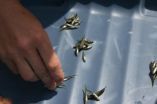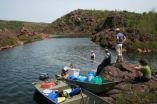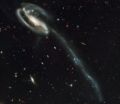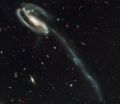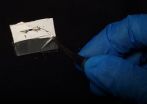(Press-News.org) Debris from forests that washes into freshwater lakes supplements the diets of microscopic zooplankton and the fish that feed off them – creating larger and stronger fish, new research shows.
The researchers warn that, as forests are eroded through human activities such as logging, the impacts will be felt in aquatic as well as terrestrial food chains.
In fact, the study was conducted at a Canadian lake chosen because it had suffered ecological disaster during the mid-20th century: acid rain as a result of the local nickel smelting industry.
Despite moves to reduce environmental impact, many areas of vegetation surrounding the lake are still in recovery. This enabled scientists to study Yellow Perch fish from different parts of a lake that has varying degrees of surrounding forest coverage.
Carbon from forest debris has a different elemental mass than carbon produced by algae in the aquatic food chain. By analysing the young Perch that had been born that year, scientists were able to determine that at least 34% of the fish biomass comes from vegetation, increasing to 66% in areas surrounded by rich forest.
Essentially, the more forest around the edge of the lake, the fatter the fish in that part of the lake were.
Scientists say that the young fish in lake areas with scant forest cover were much smaller, and consequently much less likely to survive and breed.
"We found fish that had almost 70% of their biomass made from carbon that came from trees and leaves instead of aquatic food chain sources," said Dr Andrew Tanentzap from Cambridge's Department of Plant Sciences, and lead author of the new study, published today in the journal Nature Communications.
"While plankton raised on algal carbon is more nutritious, organic carbon from trees washed into lakes is a hugely important food source for freshwater fish, bolstering their diet to ensure good size and strength," he said.
The work was conducted at Daisy Lake on the outskirts of the industrial city of Sudbury in Ontario, Canada. The area is part of the boreal ecosystem: a vast subarctic climate system that rings round most of the top of the Northern Hemisphere – full of huge, ancient forests vital to the carbon cycle of Earth.
"More than 60% of the world's fresh water is in the boreal areas such as Canada, Scandinavia and large parts of Siberia. These areas are suffering from human disturbance such as logging, mining, and forest fires resulting from climate change – all occurrences predicted to intensify in coming years," said Tanentzap.
The scientists studied eight different 'watersheds' surrounding the lake: a given area across which all the moisture drains into a single stream. When these fast-moving streams – full of detritus from forest foliage – hit the slow-moving lake, the debris falls out of suspension and sinks, forming layers of sediment which create mini deltas.
Debris is broken down by bacteria, which is in turn consumed by zooplankton: tiny translucent creatures that also feed on algae. The fish then feed on the zooplankton. Until recently, algae were believed to be the only source of food for zooplankton, but the new research builds on previous work that showed they also feed on bacteria from forest matter drained into lakes.
The researchers worked along the food chains in the mini deltas. "Where you have more dissolved forest matter you have more bacteria, more bacteria equals more zooplankton; areas with the most zooplankton had the largest 'fattest' fish," said Tanentzap.
Areas of Daisy Lake closest to the nickel smelt-works remain bare – dirt and rock instead of the once lush forest. The young fish in these parts of the lake were considerably smaller due to less available food. This leaves them susceptible to poor health and predators as they won't be as strong, so less likely to go on to breed and repopulate.
"It's estimated that freshwater fishes make up more than 6% of the world's annual animal protein supplies for humans – and the major and often only source of animal protein for low income families across Bangladesh, Indonesia and the Philippines," added Tanentzap.
"While we've only studied boreal regions, these results are likely to bear out globally. Forest loss is damaging aquatic food chains of which many humans are a part."
INFORMATION: END
Forest loss starves fish
2014-06-11
ELSE PRESS RELEASES FROM THIS DATE:
Sports teams may lose out from having 'too much talent'
2014-06-11
As the FIFA World Cup kicks off and the NBA finals "heat" up, new research suggests that there is such a thing as having too much talent on a sports team. The research indicates that, after a certain point, the addition of more superstar talent to a team can actually be detrimental, resulting in poorer team performance.
The findings are forthcoming in Psychological Science, a journal of the Association for Psychological Science.
The research, led by INSEAD Professor Roderick Swaab, showed that the presence of too many individuals with top talent can undermine players' ...
Nearby satellite galaxies don't fit standard model
2014-06-11
Satellite dwarf galaxies at the edges of the Milky Way and neighboring Andromeda defy the accepted model of galaxy formation, and recent attempts to pigeon-hole them into the model are flawed, an international team of scientists reports.
The mismatch raises questions about the accuracy of the standard model of cosmology, which is the widely accepted paradigm for the origin and evolution of the universe, the astrophysicists say.
A preprint of the research paper, accepted for publication by the Monthly Notices of the Royal Astronomical Society, is online at http://arxiv.org/abs/1406.1799.
The ...
Map of universe questioned; dwarf galaxies don't fit standard model
2014-06-11
Dwarf galaxies that orbit the Milky Way and the Andromeda galaxies defy the accepted model of galaxy formation, and recent attempts to wedge them into the model are flawed, reports an international team of astrophysicists.
David Merritt, professor of astrophysics at Rochester Institute of Technology, co-authored "Co-orbiting satellite galaxy structures are still in conflict with the distribution of primordial dwarf galaxies," to be published in an upcoming issue of Monthly Notices of the Royal Astronomical Society. A pre-print of the paper is available online at http://arxiv.org/abs/1406.1799.
The ...
Improvements in MRIs, other image-detection applications on the horizon
2014-06-11
LIVERMORE, Calif. — Researchers at Sandia National Laboratories, along with collaborators from Rice University and the Tokyo Institute of Technology, are developing new terahertz detectors based on carbon nanotubes that could lead to significant improvements in medical imaging, airport passenger screening, food inspection and other applications.
A paper in Nano Letters journal, "Carbon Nanotube Terahertz Detector," debuted in the May 29 edition of the publication's "Just Accepted Manuscripts" section. The paper describes a technique that uses carbon nanotubes to detect ...
Experts unlock key to blood vessel repair
2014-06-11
Scientists from the University of Leeds have found a way to restore the function of damaged blood vessel repairing cells, in a potentially important step for the future treatment of heart disease.
The research, part-funded by the British Heart Foundation (BHF), could also pave the way for new targets for drug development in the fight against heart disease.
The findings have also identified a potential reason why South Asian men in the UK experience an increased risk of heart disease.
Led by Dr Richard Cubbon in the School of Medicine, the research team studied cells ...
New research could provide key to overcoming resistance to HER2 targeted cancer treatments
2014-06-11
Dublin, Ireland, June 11th, 2014 – Scientists from the School of Pharmacy & Pharmaceutical Sciences, Trinity College Dublin have made a significant discovery of a new biomarker which may help overcome resistance to newer and more targeted anti-cancer drugs, such as Herceptin, for HER2 positive cancers. These findings may also help the early identification of patients who will benefit more from these treatments.
The researchers, led by Professor Lorraine O'Driscoll, Associate Professor of Pharmacology, Trinity, studied breast cancer cells and their extracellular vesicles ...
International team unearths genetic risk factor for type 2 diabetes in Latin American populations
2014-06-10
In the largest study of its kind published to date, an international team of researchers in Mexico and the United States has discovered a strong genetic risk factor for type 2 diabetes that primarily affects Latin American patients, but is rare elsewhere. The work further characterizes a gene called HNF1A, responsible for a rare, inherited form of diabetes against which a widely available and inexpensive class of drugs is highly effective. The discovery offers important new clues about the population genetics of type 2 diabetes in Latin American populations, and suggests ...
NREL finds up to 6-cent per kilowatt-hour extra value with concentrated solar power
2014-06-10
Concentrating Solar Power (CSP) projects would add additional value of 5 or 6 cents per kilowatt hour to utility-scale solar energy in California where 33 percent renewables will be mandated in six years, a new report by the Energy Department's National Renewable Energy Laboratory has found.
The report, "Estimating the Value of Utility-Scale Solar Technologies in California Under a 40% Renewable Portfolio StandardPDF," finds that CSP, with its ability to store energy for several hours or more, helps maintain firm capacity in the hours when the sun is below the horizon. ...
Report reviews estimates of costs and benefits of compliance with renewable portfolio standards
2014-06-10
A new report, prepared by analysts from the Energy Department's National Renewable Energy Laboratory (NREL) and Lawrence Berkeley National Laboratory (LBNL), reviews estimates of the costs and benefits of compliance with Renewable Portfolio Standards (RPS) in the United States and explores how costs and benefits may evolve over time.
"A Survey of State-Level Cost and Benefit Estimates of Renewable Portfolio StandardsPDF," reviews recent estimated RPS costs for most states, but finds that a lack of benefits estimates and methodological differences limit the ability to ...
Crescendo Bioscience to present multiple studies at 2014 EULAR Meeting
2014-06-10
SALT LAKE CITY, Utah, June 10, 2014 – Crescendo Bioscience, a wholly-owned subsidiary of Myriad Genetics, Inc. (NASDAQ: MYGN), today announced that Vectra® DA data will be featured in eight posters at the 2014 European League Against Rheumatism (EULAR) Annual Meeting, June 11-14, 2014, in Paris, France. Vectra DA is a quantitative, objective multi-biomarker test to measure disease activity in patients with rheumatoid arthritis (RA). The Vectra DA test offers insight into the biological processes that drive disease activity to help rheumatologists manage RA and improve ...
